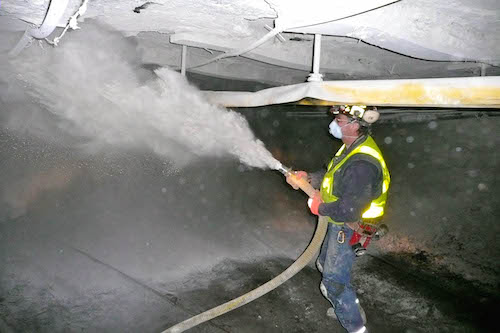Silica has been around since the dawn
of civilization
and its dangers have been known since at least the days of the
New Deal. In fact, President Roosevelt’s labor secretary called it a deadly
hazard. Now, four decades after the first regulation, there is a
new rule to protect working men and
women from its debilitating effects.
“This is good news, not just for our members who work around silica, but for their families too,” said International President Lonnie R. Stephenson. “This is a rule that will save lives.”
The Department of Labor’s Occupational Safety and Health Administration issued a rule on March 25 that limits exposure to respirable crystalline silica, a substance commonly found at a variety of worksites. The rule creates two standards, one for the construction industry and one for the maritime and general industry. Both standards require a reduction of the permissible exposure limit to 50 micrograms per cubic meter of air, averaged over an eight-hour shift. The previous standard for construction sites was five times that, with a cap of 250 micrograms.

|
| After decades in the making, OSHA has issued a new rule to increase protections from silica, a commonly found substance with potentially deadly consequences.
|
The rule also requires employers to implement dust controls, like using water to dampen the silica and installing better ventilation. Additionally, employers must offer respirators and medical exams and limit access to high exposure areas.
Silica is found in a number of places, particularly in rocks and sand. OSHA says it is typically 100 times smaller than sand found on beaches, if not more, and is generated by high-energy operations including cutting, sawing, grinding and crushing stone, or when using industrial sand. Sawing brick, blasting with sand, drilling into concrete walls, grinding mortar, crushing stone or manufacturing brick, concrete or ceramics can all generate this respirable dust. As such, industries from construction to railroads to foundries and glass manufacturing are affected.
When inhaled, it can penetrate deep into a person’s lungs and cause silicosis, an incurable and potentially fatal disease. Silica exposure can also cause lung cancer, respiratory diseases like chronic obstructive pulmonary disease and kidney disease. The World Health Organization and the National Institutes of Health designate it as a known human carcinogen.
OSHA estimates that more than 2 million working men and women are exposed to silica in their workplaces. The majority, 1.85 million, are in the construction industry. This new rule is expected to save nearly 700 lives and prevent 1,600 new cases of silicosis a year.
The last time a rule on silica was issued was in 1971, when OSHA was created. Even then, officials knew from existing research that it wasn’t strong enough.
"We've known for over 40 years that it needed to be strengthened, and it has taken 40 years to strengthen it," Labor Secretary Thomas Perez told NPR. "Many people who are going to work right now and breathing unacceptable levels of silica dust are in for a brighter future."
IBEW Director of Safety Dave Mullen says that IBEW has been pushing for this rule.
“We’ve been working with other building trades, writing letters to President Obama, doing whatever we could to get the rule finalized,” Mullen said. “We’re pleased to see that it’s out, and not a day too soon.”
Both standards will take effect on June 23. Industries will then have one to five years to comply with most of the requirements. For construction, they will need to be in full compliance by June 23, 2017. For general industry and maritime, there is an extra year, with a deadline of June 23, 2018.
OSHA calculates the cost to employers to be about $1 billion. When the benefits, of reduced mortality and disease among others, are factored in though, OSHA estimates a net benefit of approximately $4 to $8 billion.
Despite the benefits, various industry employer groups have filed suit against the rule. North America’s Building Trades unions also filed a challenge regarding a portion of the rule that deals with medical exams. IBEW is a member of the building trades.
“We support this rule and its increased protections for our members,” Mullen said. “But there is room for improvement regarding this particular requirement.”
For additional information, go to OSHA’s web page on silica.